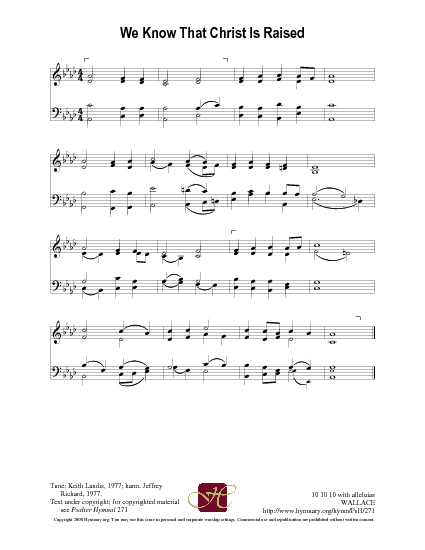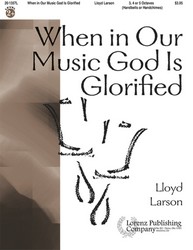- |
User Links
We Know that Christ Is Raised

We know that Christ is raised and dies no more
Author: John Geyer (1967)Tune: ENGELBERG
Published in 29 hymnals
Printable scores: PDF, MusicXMLAudio files: MIDI, Recording
Author: John Geyer
(no biographical information available about John Geyer.) Go to person page >Text Information
Related Texts
| First Line: | We know that Christ is raised and dies no more |
| Title: | We Know that Christ Is Raised |
| Author: | John Geyer (1967) |
| Meter: | 10.10.10 with alleluias |
| Language: | English |
| Copyright: | © John B. Geyer |
- Year A, Easter season, Easter Vigil
This is recommended for Year A, Easter season, Easter Vigil by 2 hymnal lectionary indexes including Glory to God: the Presbyterian Hymnal #485 and Lift Up Your Hearts: psalms, hymns, and spiritual songs #795. - Year A, Easter season, Easter Day
Related to Colossians 3 (NPM) - Year A, Easter season, Second Sunday
- Year A, Easter season, Fourth Sunday
Related to Acts 2 and 1 Peter 2 (NPM) - Year A, Ordinary Time, Proper 7 (12)
This is recommended for Year A, Ordinary Time, Proper 7 (12) by 3 hymnal lectionary indexes including Glory to God: the Presbyterian Hymnal #485 and Lift Up Your Hearts: psalms, hymns, and spiritual songs #795. - Year A, Ordinary Time, Proper 10 (15)
This is recommended for Year A, Ordinary Time, Proper 10 (15) by 2 hymnal lectionary indexes including Lift Up Your Hearts: psalms, hymns, and spiritual songs #795. - Year B, Lent, First Sunday
This is recommended for Year B, Lent, First Sunday by 2 hymnal lectionary indexes including Lift Up Your Hearts: psalms, hymns, and spiritual songs #795. - Year B, Easter season, Easter Vigil
This is recommended for Year B, Easter season, Easter Vigil by 2 hymnal lectionary indexes including Glory to God: the Presbyterian Hymnal #485 and Lift Up Your Hearts: psalms, hymns, and spiritual songs #795. - Year B, Easter season, Easter Vigil
- Year B, Easter season, Easter Day
Related to Colossians 3 (NPM) - Year B, Easter season, Easter Evening
- Year B, Easter season, Fifth Sunday
- Year B, Ordinary Time, Proper 25 (30)
- Year C, Epiphany season, Fifth Sunday
This is recommended for Year C, Epiphany season, Fifth Sunday by 2 hymnal lectionary indexes including Glory to God: the Presbyterian Hymnal #485. - Year C, Easter season, Easter Vigil
This is recommended for Year C, Easter season, Easter Vigil by 2 hymnal lectionary indexes including Glory to God: the Presbyterian Hymnal #485 and Lift Up Your Hearts: psalms, hymns, and spiritual songs #795. - Year C, Easter season, Easter Vigil
- Year C, Easter season, Easter Day
This is recommended for Year C, Easter season, Easter Day by 2 hymnal lectionary indexes including Glory to God: the Presbyterian Hymnal #485. - Year C, Easter season, Fifth Sunday
- Year C, Easter Season, Seventh Sunday
- Year C, Ordinary Time, Proper 12 (17)
This is recommended for Year C, Ordinary Time, Proper 12 (17) by 2 hymnal lectionary indexes including Glory to God: the Presbyterian Hymnal #485 and Lift Up Your Hearts: psalms, hymns, and spiritual songs #795. - Year C, Ordinary Time, Proper 12 (17)
English
- Catholic Book of Worship III #398
- Chalice Hymnal #376
- Christian Worship: Hymnal #683
- Church Hymnary (4th ed.) #635
- Ecumenical Praise #111
- Evangelical Lutheran Worship #449
- Glory to God: the Presbyterian Hymnal #485
- Hymnal Supplement 98 #846
- Hymnal Supplement II #72
- Hymnal: a worship book #443 10 shown out of 29
Korean
Notes
Scripture References:
st. 2 = Rom. 6:3-5, Col. 2:12
The author, John B. Geyer, writes:
“We Know That Christ Is Raised" was written in 1967, when I was tutor at Cheshunt College, Cambridge, U.K At that time a good deal of work was going on 'round the corner (involving a number of American research students) producing living cells ("the baby in the test tube"). The hymn attempted to illustrate the Christian doctrine of baptism in relation to those experiments.
John B. Geyer (b. Wakefield, Yorkshire, England, 1932) is an Old Testament scholar who has written widely in his field. He wrote a commentary on The Wisdom of Solomon (1973) as well as a number of hymns that were first published in various British supplementary hymnals. Educated at Queen's College, Cambridge, and Mansfield College, Oxford, he also studied Old Testament under Gerhard von Rad in Heidelberg. In 1959 Geyer was ordained in the Congregational Union of Scotland. He served as a chaplain at the University of St. Andrews, pastor of Drumchapel Congregational Church in Glasgow, Scotland, and a college tutor. In 1969 Geyer became minister in the (now) United Reformed Church in Little Baddow. Since 1980 he has served as pastor at Weoley Hill, Birmingham, and as chaplain at the University of Birmingham, England.
The text was first published in the British Methodist supplementary hymnal Hymns and Songs (1969) but has since been altered in various other hymnals, including the Psalter Hymnal. The controlling thought comes from Romans 6:3-5, in which Paul teaches that in baptism we are united with Christ in his resurrection–that is the basis for our new life. Like 269, this song ends each stanza with a note of praise–in this case with an "alleluia" refrain line.
Liturgical Use:
Infant or adult baptism; Easter.
--Psalter Hymnal Handbook
Tune
ENGELBERGCharles V. Stanford (b. Dublin, Ireland, 1852; d. Marylebone, London, England, 1924) composed ENGELBERG as a setting for William W. How's "For All the Saints" (505). The tune was published in the 1904 edition of Hymns Ancient and Modern with no less than six different musical settings. It is clearly…
Timeline
Arrangements
Media
- Audio recording from Evangelical Lutheran Worship #449
- Audio recording from Glory to God: the Presbyterian Hymnal #485
- Audio recording from Lift Up Your Hearts: psalms, hymns, and spiritual songs #795
- Audio recording from Lift Up Your Hearts: psalms, hymns, and spiritual songs #795
- Audio recording from Lift Up Your Hearts: psalms, hymns, and spiritual songs #795
- Audio recording from Lift Up Your Hearts: psalms, hymns, and spiritual songs #795
- MIDI file from Psalter Hymnal (Gray) #271
- MIDI file from Psalter Hymnal (Gray) #271
- Audio recording from The United Methodist Hymnal #610


 My Starred Hymns
My Starred Hymns






